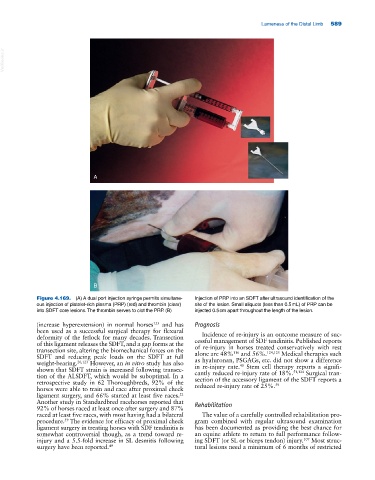Page 623 - Adams and Stashak's Lameness in Horses, 7th Edition
P. 623
Lameness of the Distal Limb 589
VetBooks.ir
A
B
Figure 4.169. (A) A dual port injection syringe permits simultane- Injection of PRP into an SDFT after ultrasound identification of the
ous injection of platelet‐rich plasma (PRP) (red) and thrombin (clear) site of the lesion. Small aliquots (less than 0.5 mL) of PRP can be
into SDFT core lesions. The thrombin serves to clot the PRP. (B) injected 0.5 cm apart throughout the length of the lesion.
123
(increase hyperextension) in normal horses and has Prognosis
been used as a successful surgical therapy for flexural Incidence of re‐injury is an outcome measure of suc-
deformity of the fetlock for many decades. Transection
of this ligament releases the SDFT, and a gap forms at the cessful management of SDF tendinitis. Published reports
of re‐injury in horses treated conservatively with rest
transection site, altering the biomechanical forces on the 116 124,125
SDFT and reducing peak loads on the SDFT at full alone are 48% and 56%. Medical therapies such
as hyaluronan, PSGAGs, etc. did not show a difference
weight‐bearing. 20,123 However, an in vitro study has also 40
shown that SDFT strain is increased following transec- in re‐injury rate. Stem cell therapy reports a signifi-
51,124
cantly reduced re‐injury rate of 18%.
Surgical tran-
tion of the ALSDFT, which would be suboptimal. In a
retrospective study in 62 Thoroughbreds, 92% of the section of the accessory ligament of the SDFT reports a
59
reduced re‐injury rate of 25%.
horses were able to train and race after proximal check
ligament surgery, and 66% started at least five races.
21
Another study in Standardbred racehorses reported that Rehabilitation
92% of horses raced at least once after surgery and 87%
raced at least five races, with most having had a bilateral The value of a carefully controlled rehabilitation pro-
procedure. The evidence for efficacy of proximal check gram combined with regular ultrasound examination
59
ligament surgery in treating horses with SDF tendinitis is has been documented as providing the best chance for
somewhat controversial though, as a trend toward re‐ an equine athlete to return to full performance follow-
107
injury and a 5.5‐fold increase in SL desmitis following ing SDFT (or SL or biceps tendon) injury. Most struc-
surgery have been reported. 49 tural lesions need a minimum of 6 months of restricted

